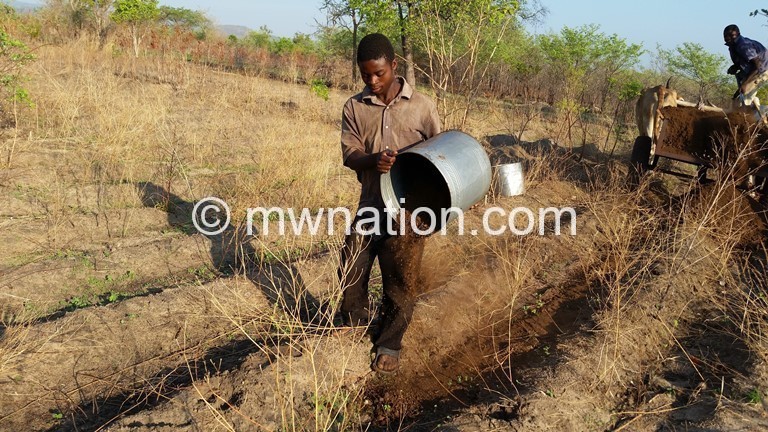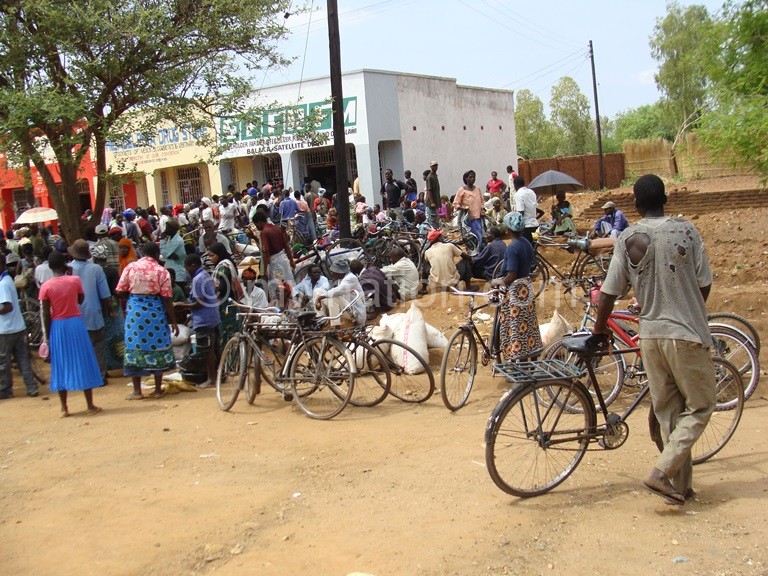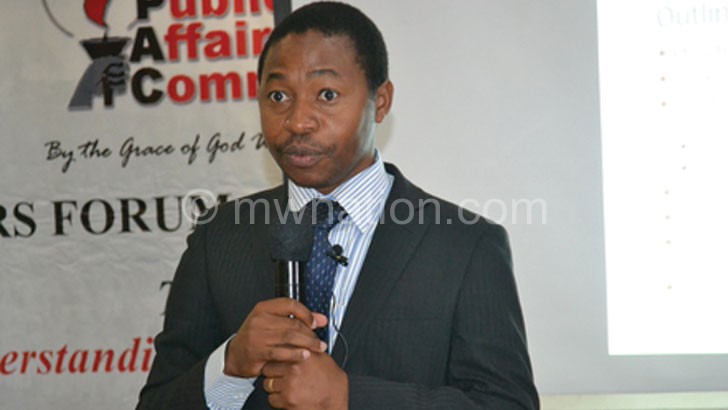Food prices fly away as trees fall
As Malawi’s forests get thinner, farmers haunted by chronic food shortage could be seeing a worsening crisis closer than policymakers in the comfort of airplanes constantly flying past their degraded crop fields.
“We see airplanes every day, but we have never been on board. Soon the situation will be the same with food. We will have foodstuffs within sight, but keep starving because we cannot afford it,” says village head Mdala in Chief Kuntaja’s territory west of Chileka Airport in Blantyre.

Flying across the countryside, planeloads of travellers get a bird’s eye view of treeless crop fields where sporadic lush spots are mostly confined to graveyards.
The sprawling bare farmlands are seen heavily gullied as rainwater running off the ground washes the thin layer of topsoil into nearby streams which appear murky if not buried in silt.
For passengers touching down and taking off at Chileka, the sight of topsoil racing to the muddy streams bombards them all the way to the upper and lower valleys of the Shire River, the sole outlet of Lake Malawi.

The country’s largest river is the setting of turbines that generate nearly all electricity going into the national grid, which serves just over a tenth of the population. Many a times the silt and debris from deforested highlands slow dynamos on the Shire River, causing hiccups in power production.
The blackouts become more frequent, sustained and lengthy in the rainy season, increasing the use of firewood and charcoal for cooking while further exposing the soil in a vicious cycle of environmental degradation which paralyses the ailing economy.
‘Hunger is part of life’
Farmers in the remote villages in Blantyre West—where transmission lines from Nkula Hydropower Generation Scheme hover past excluded rural homesteads as do the planes leaving or arriving at the colonial airport—is a major source of charcoal trafficked to Blantyre City day and night.
The locals call it their black gold because the illicit trade generates income that helps them overcome hunger and poverty caused by declining harvests in farmlands where speeding winds freely whirl away clouds of dust, carrying away loose grains of soil and crop residues that morph into manure when they rot.
But GVH Mdala, who laments skyrocketing food prices as harvests dwindle in the charcoal heartland, is worried about both the loss of trees and fertile soils on farmlands whose size per household is shrinking amid rapid population growth.
“Deforestation and land degradation point to more hardship. These days, food shortage is no longer looming. It is part of life, a chronic problem,” he explains. “We are already struggling to feed ourselves and you cannot figure out how our grandchildren and their children will feed their families if we continue wiping out trees due to the aroma of money from the city where charcoal sells like hot cakes.”
From his village, the traditional leader has seen his territory lose fertile soils at an alarming rate to running rainwater, whirlwinds and summer fires lit to clear the barren fields in readiness for the next growing season.
This, he says, makes the future bleak as land degradation is on the increase at a time rains have become unpredictable, erratic and “more likely to lead to either devastating floods or prolonged dry spells than bumper harvests”.
He states: “If you cannot afford fertiliser, then you cannot fill a bag of maize. Sometimes, even if you apply fertiliser two times, the rains stop just when the maize is tasseling.
“Many people are stuck in hunger and poverty because the fields have lost soil fertility when rains have become tricky. We are paying a huge price for environmental degradation.”
A global loss
According to the United Nations’ Food and Agriculture Organisation (FAO), Malawi, where agriculture employs about 80 percent of its population, loses up to 29 tonnes of topsoil per hectare every year.
A farmer would need an articulated truck to carry the soil that would have nourished either food or cash crops had it not been washed away without any vegetation to stop the loss.
The silent tragedy is panning out ceaselessly as FAO reports that over a third of the earth soils are already degraded and just a tenth could remain good for farming by 2050. On the flipside, FAO reports, it can take up to 1 000 years to form just two to three centimetres of soil.
It reports: “Soil may not look like much but without it, we wouldn’t be able to produce our food. But soil erosion threatens our food security. Every five seconds, the equivalent of one soccer pitch is eroded.
“Once we lose this soil, we won’t see it again in our lifetime. If we don’t act now, over 90 percent of the earth could be degraded by 2050. We need to protect our soil for a secure future of our food.”
Tipping point
Dane Fredenburg, chief of party at the Catholic Relief Services (CRS), said during the 2018 national forestry talks in Lilongwe that restoring soil health for smallholder farmer’s resilience to climate change is a must.
He decries the “crisis of land degradation” both on farm and landscapes, the negative spiral will massively increase the need for emergency relief as well as vulnerability, migration and conflicts in the country where over one million people require food aid every year.
He explains: “The silent catastrophe includes loss of trees, grass and topsoil. Malawi may be on a tipping point in that the soil organic matter is becoming too low to support crop production. People are already poor, land size is already small and the population is growing fast.”
The agricultural economy is already paying a huge price.
Last year, the cost of a 50-kilogramme bag of maize more than tripled from K5 000 to K19 000 amid Malawi Vulnerability Assessment Committee (Mvac) reported that about 1.8 million people needed emergency food aid by the start of the lean season in January.
For the past five years, one million to three million Malawians require food aid every year.
The irony with a decade-old farm input subsidy is that almost the same number of farmers the State-funded programme—pegged at K45 billion and K35 billion in the past two years—aims to lift out of hunger and poverty persistently require food aid. The ending lean season marks anticlimactic close to the year the subsidy consumed K41 billion.
Lived reality
Atise Mathumba, 70, has witnessed the silent crisis throughout his life as the population, now estimated at 17.6 million, takes down trees in search of firewood as well as to expand farmland and settlements.
The farmer based, from Nyimbiri Village in Zomba, says farming was cheap when soils needed only rainfall, not chemical fertiliser, to produce abundant yields.
“The topsoil was rich in nutrients. At that time, farming was a matter of clearing the land, planting crops, weeding and minimum care. Yet we used to harvest three or four times what we are getting from the degraded spots nowadays,” he explains with resentful nostalgically.
The farmer, excluded from the seed and fertiliser subsidy, applies manure from crop residues and animal droppings to swell his family’s harvest and renew soil fertility and moisture retention.
In this way, he still harvests more than his neighbours not only hit hard by climate change and environmental degradation.
“There is good news,” he says. “The current setback on food production can be reversed fairly quickly with joint and sufficient efforts to bring back thick green cover that conserved soil fertility, moisture and texture from drought, rainwater, run-offs and wind.”
But the main concern is that the country, with a deforestation rate of up to three percent a year, is replenishing the green canopy much slower than it is waning.
This brings into question the pace of numerous reforestation initiatives by government and non-governmental organisations, which include the national tree-planting season presidents launch every year. They also include planting trees in crop fields, community woodlots, farmer-managed natural regeneration and growing bamboo for firewood, fencing, poles and farmland boundaries
Government envisioned Malawians planting 60 million trees by April, but director of forestry Stella Gama says the nation is unlikely to meet the target as her department has only tracked 15 million seedlings planted in all 28 districts.
To roll back the greatest threat to soil health, FAO has trained with farmers in Mathumba and (GVH) Mdala on a soil conservation project to strengthening community resilience to climate Change.
The initiative implemented by Total Land Care (TLC) and Evangelical Association of Malawi (EAM) in partnership with the Ministry of Agriculture, Irrigation and Water Development targets 7 200 smallholder farmers in Blantyre Rural, Zomba, Neno and Phalombe to achieve food security by restoring soil well-being.
Conserving soils
Horrified by the effects of land degradation and massive deforestation, the farmers have embraced manure-making, tree-planting, natural forest regeneration, soil and water management, crop diversification and drought-resistant crops.
Others have stopped relying on unpredictable rains only. They now harvest three times a year, thanks to irrigation powered by solar.
Churning out manure from crop residues, Liznet Katema of Ufulu farmer field school in Dzomodya Village, Neno, says she will not regret being one of the change agents.
Last year, she harvest 10 bags from a plot where she got just two five years when she was using chemical fertiliser.
She brags: “Sustainable agriculture reduces the number of poor and hungry families, helps combat climate change and preserves natural resources. Most importantly, it has helped us realise that this is our land, which we inherited from our ancestors to be passed on to our children. We have a duty to take care of it.”
Mathews Mwale, TLC field coordinator for Lirangwe Extension Planning Area in Blantyre, is happy that community members are aware of their contribution to the land and environmental degradation.
“It is pleasing that community members are working together to conserve the environment for their improved livelihoods. If they know this is the main asset they have, the main source of livelihood, land becomes more productive and its guardians take care of it to harvest more.” n





